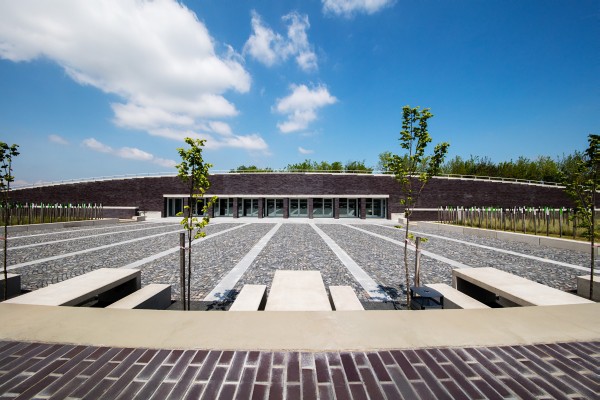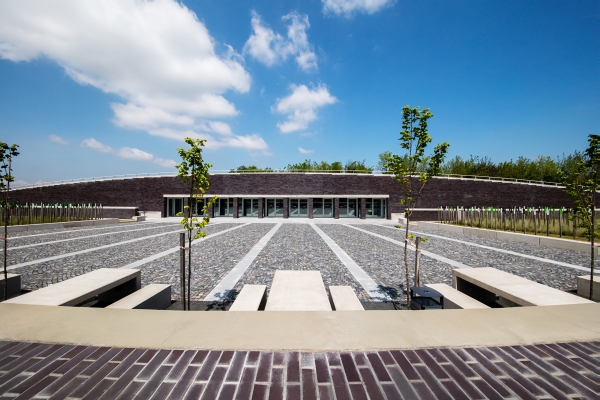Contours of Cultural Memory
St Ladislaus’ National Memorial Site Visitors’ Centre, Somogyvár
Architects: Csaba Molnár, Viktor Szentkuti, Dénes Halmai
Text: Eszter Baku
Photos: Tamás Bujnovszky

Launched in 2012, the complex programme meant to develop the visitors’ centre of the St Ladislaus’ memorial site of the Benedictine abbey ambitioned to preserve the existing conditions of the ruins, to display the stone carvings found during the archaeological excavations exploring the history of the complex in an interactive exhibition, as well as to present the personality of the founding king. Adjusting to the faculties of the terrain and the site, the reception building nestles up to the foot of the castle hill. As a result, the visual integrity of the ruins and the visitors’ centre is only visible from the look-out right next to the abbey, which also marks the axis of the structure. To bridge over the level shift and distance between the two blocks an accessible path for pedestrians was built which creates continuous communication route between the two areas. The visitors’ centre is essentially divided into four independent functional units: the reception building, the arrival structure, the in-between area, as well as an outdoor venue for events and the rampart. Sunk into the ground, the house has an architectural concept the essence of which is to communicate with the ruins of the abbey non-stop whilst evoking the formerly luxurious complex by preserving the parts that have actually been preserved within its horizontal plan, whilst the new structure also connects with the remains of the abbey complex via its materials: the dominance of stone and brick here harmonizes mainly with the dual character of brick and concrete. The ramparts may be interpreted as reminiscences of the ruinous masonry walls, their sweeping arch continues the arched main facade of the reception building, at each end of the ramparts there is characteristic exposed concrete gateway communicating with the arrival building. The non-stop dialogue is reinforced by the playful lines of the spectacularly patterned timber structure walkway set on which almost levels the faculties of the terrain. As is nestles into its environment, it creates harmonious integrity made complete with the contextual components surrounding and enveloping the building, such as the orchard, the vineyard and the lavender patches.
Leading architects: Csaba Molnár DLA, Viktor Szentkuti, Dénes Halmai
Architecture: M Építész Iroda Kft.
Fellow architects: Tamás Vörös, Regina Pethő, Viktória Istók, Lilla Boróka Koch
Framework: Dr. Miklós Armuth, Dóra Debkowski – Adeco Kft.
Structure: Dr. László Kakasy – Kakasy és Társa Kft.
HVAC: Albert Lovas – OptiTerv Kft.
Electrical engineering: Csaba Zentai – Három Zentai Kft.
Landscape: Rita Remeczki, Edina Massány – Open Air Design Kft.
Rehabilitation: András Pandula – Épített Környezetért Alapítvány
Exhibition installation: Ádám Tubákos, Nóra Lukácsi, Szabolcs Császár – OPADI Studio Kft.
Graphic design: Ádám Tubákos, Petra Vass, Ildikó Sztolyka, Péter Morvai, János Fránkó – OPADI Studio Kft.
Curators of the exhibition: Attila Győr, Veronika Nagy, Gábor Gaylhoffer-Kovács
Client: Forster Gyula Nemzeti Örökségvédelmi és Vagyongazdálkodási Központ
Main contractor: Laki Épületszobrász Zrt.










